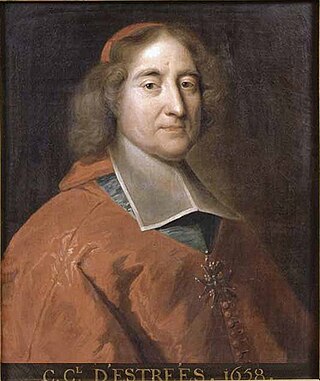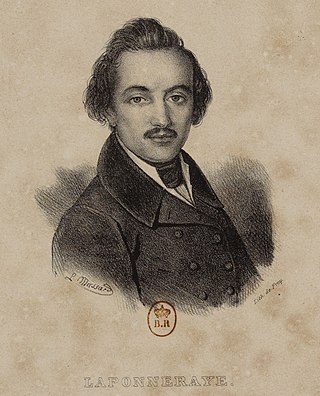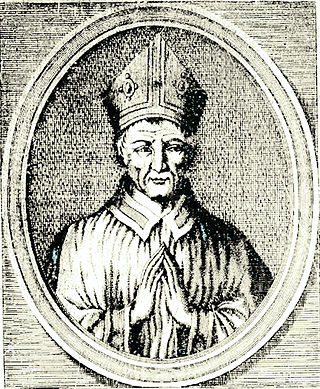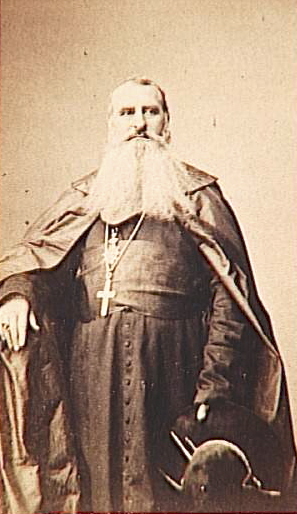Related Research Articles
Marie Nicolas Sylvestre Guillon, was a French ecclesiastic, and librarian.

The Archdiocese of Reims or Rheims is a Latin Church ecclesiastic territory or archdiocese of the Catholic Church in France. Erected as a diocese around 250 by Sixtus of Reims, the diocese was elevated to an archdiocese around 750. The archbishop received the title "primate of Gallia Belgica" in 1089.

César d'Estrées was a French diplomat and cardinal.

The Diocese of Nancy and Toul is a Latin Church ecclesiastical territory or diocese of the Catholic Church in France. After a considerable political struggle between Louis XV, Louis XVI, and the Dukes of Lorraine, the diocese was erected by Pope Pius VI on 17 December 1777. The Diocese of Nancy is a suffragan diocese in the ecclesiastical province of the metropolitan Archdiocese of Besançon.

The Diocese of Tarbes et Lourdes is a Latin Church ecclesiastical territory or diocese of the Catholic Church in France. Until 2002 Tarbes was a suffragan of the Archdiocese of Auch. It is now a suffragan of the Archdiocese of Toulouse.

Philippe-Andre Grandidier was an 18th-century French priest and historian.

Paul François de Quélen de Stuer de Caussade, 2nd Duke of La Vauguyon and sometimes mistakenly Paul François de Quélen de Stuer de Caussade de La Vauguyon was a French nobleman. He was governor of Cognac, after having been involved in the last campaigns of the Seven Years' War. He wrote a Portrait de feu monseigneur le Dauphin and was menin to the future Louis XVI, one of the Dauphin's sons. A peer of France, brigadier, maréchal de camp, knight of the ordre du Saint-Esprit, he was chosen to be minister plenipotentiary to the Estates General of the Dutch Republic. He later became French ambassador to Spain, knight of the Golden Fleece, temporary minister of foreign affairs in 1789, then minister of the conseil d'État of Louis XVIII in Verona. He was the main intermediary among Louis's agents in France, but became the victim of intrigues. From the Restoration onwards he was lieutenant général and sat in the peerage of France, where he was noted for his moderation. He and his wife had four children, but the Quelen line ended with his children.
Henri de Nesmond was a French churchman, bishop of Montauban, archbishop of Albi and archbishop of Toulouse.

Grestain Abbey was an 11th-Century Benedictine monastery near the town of Fatouville-Grestain, which is located in the modern-day Eure département of Upper Normandy, France. The abbey was in the Catholic Diocese of Lisieux. Closely associated with the family of William, Duke of Normandy, the abbey was instrumental in the Normans taking control over the Church in England in the centuries following the Norman Conquest of England, establishing new churches and priories in England, and Abbots of Grestain ordained many English priests. Many churches mentioned in the Domesday Book of 1086 cite Grestain as the founding establishment.

Albert Laponneraye was a French republican socialist and journalist, popular historian, educator and an editor of Robespierre's writings. He was a representative of the Neo-Babouvist tendency in the 1840s, along with Richard Lahautière, Jean-Jacques Pillot and others. He combined Jacobin republicanism with egalitarian communism and anti-clericalism. He was influenced by the doctrines of Philippe Buonarroti and Étienne Cabet. In the 1830s and 40s Laponneraye was one of the best known advocates of republican communism. He is viewed as a forerunner of Karl Marx.
Antoine de Castelnau,, Bishop of Tarbes, was a French diplomat, who served as an ambassador to England and Spain during the reign of Francis I.

Edmond Demolins (1852–1907) was a French pedagogue.

Pierre Aycelin de Montaigut or Montaigu, Montagu, known as Cardinal de Laon, born between 1320 and 1325 and died 8 November 1388, was a fourteenth-century French cardinal, who was the bishop of Nevers (1361–1371) and bishop of the Diocese of Laon (1371-1386), advisor to the king of Charles V and peer of France.

Ignatius Cazeneuve was a constitutional bishop and French politician during the French Revolution. Ignace de Caseneuve of Gap was elected the constitutional bishop of Hautes Alpes on 8 March 1791. He had been a cathedral canon but had gained notoriety as a member of the City Council of Gap in July 1790.

Amable Tastu, born Sabine Casimire Amable Voïart, was a 19th-century French poet and writer.

Louis-Antoine-Augustin Pavy (1805–1866) was a French Catholic prelate who served as the second Bishop of Algiers from 1846 to 1866. He attempted to convert the Arabs to Catholicism. He denounced socialism, rampant among French colonists, as the work of the devil.
Augustin Fliche was a 20th-century French historian who mainly dealt with the history of the Church in the Middle Ages. He was a professor at the University of Montpellier and also visiting professor at the University of Leuven in 1925–1927 and 1946–1947.
Loup de Bayeux, saint Loup or sometimes saint Leu was a bishop of Bayeux between 440 and 470.
Honoré Jean Pierre Fisquet (1818–1883) was a French historian, biographer and writer of guide books, including a Nouveau guide général du voyageur en Angleterre, en Écosse et en Irlande (1864), which he wrote together with Henri-Marie Martin and published under the pseudonym William Darcy. He was born in Montpellier on 16 June 1818 and died in Paris on 27 July 1883.
Menelphalus was a 5th-century metropolitan archbishop of Aix. He seems to have followed Maximus or Maxime, who served in 419 when Pope Boniface ordered him and other bishops to investigate another Maximus, the bishop of Valence, for the charges of Manichean heresy. This means Menelphalus likely served as bishop in the 420s, and he is given the floruit of 420 or 425. Duchene questioned the 5th-century date entirely as an arbitrary decision as the only reference he could find to the saint was from the 9th-10 centuries, however the necropolis from which Menelphalus was moved appears to be from Late Antiquity, and the see of Aix was only established or restored in the 5th century, so Menelphalus is likely to have served between the death of Maximus and the accession of Basilius. It should also be noted that St. Basilius constructed the Cathedral of Aix around 500AD and future archbishops were buried there, whereas Menelphalus was buried in the Old Chapel of St. Lawrence. Additionally, Armentarius is an uncommon name, so for it to appear in Menelphalus' reliquary plaque as well being the name of a 5th-century chorbishop of the nearby Embrun led some to believe that St. Armentarius of Embrun was Menelphalus' successor, given that Menelphalus' name appears to have precedence over him. On the other hand, Joseph Hyacinthe Albanés felt certain that the venerated saint Menelphalus would not have been involved in the illegal consecration of Armentarius over Embrun, which caused much controversy at the time, making Albanés date Menelphalus towards the end of the 5th century.
References
- ↑ Mathieu-Richard-Auguste Henrion, Histoire de France depuis l'établissement des Francs dans la Gaule jusqu'à nos jours, Paris : Bibliothèque ecclésiastique, 1837 vol.1, p.303
- ↑ Honoré Fisquet, La France pontificale (Gallia christiana), histoire chronologique et biographique des archevêques et évêques de tous les diocèses de France depuis l'établissement du christianisme jusqu'à nos jours, divisée en 17 provinces ecclésiastiques - Métropole de Reims - Reims, Paris : E. Repos, 1864-1873, pp.52-53
- ↑ M.-R.-A. Henrion, Histoire de France, 1837, vol.1, p.303.